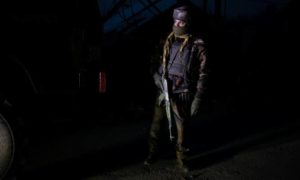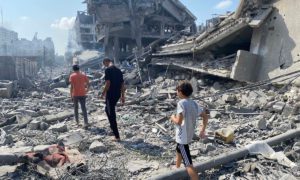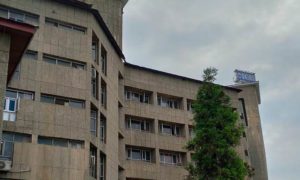With ‘Health for all – everyone, everywhere’ motto, the World Health Organization (WHO) enters its 69th year of celebrating World Health Day on April 7, 2019. However, the painful state of health continues in Kashmir, where the poor peripheral healthcare (PHC) system and inefficient lifesaving measures continue to kill people.
There’s a crucial time in emergency treatment called golden hour by healthcare professionals. It refers to the period of time following a traumatic injury, during which there’s the highest likelihood when prompt medical and surgical treatment can prevent death. But given the statistics and vitality of time factors, most of the golden hours are lost in Kashmir, leading to the death of many who could have been saved, had the healthcare system available been efficient enough.
Providing basic healthcare facilities to patients in Kashmir is becoming a dreadful task for the overworked Kashmiri doctors. In addition to the daily care, dealing with regular patients, the hospitals and healthcare centres in Kashmir face a tremendous challenge of treating patients affected by the Kashmir conflict. The inefficiency of PHCs, dearth of doctors and lack of investment of funds by the government are the reasons that make the healthcare system, a failure here.
According to the 2018 data provided by the Directorate of Healthcare in Kashmir, there’re 2102 health institutions in Kashmir division to cater to the needs of around 1.47 crore inhabitants across Jammu and Kashmir. There’re only 9 District Hospitals in Kashmir. While Anantnag, Baramulla, Budgam, Kargil, Kulgam, Leh, Pulwama and Srinagar have one district hospital each. Bandipora, Ganderbal and Shopian have none.
Given the day to day life in Kashmir and rise of gunfights, protests and “collateral damage”, the absence of district hospitals or presence of inefficient hospitals makes it impossible to save the life of an injured person who ends up succumbing to injuries.

Representational picture
Most of the districts barring Kulgam and Srinagar have no Emergency/ trauma centres. Kashmir Division has 50 sub- District Hospitals (SDH/CHC), 232 Primary Health Centres (PHC/ MMC) and 1468 Sub-centres, according to the senior doctors at three of the most availed hospitals—Shri Maharaja Hari Singh (SMHS) Hospital, Bone and Joints Hospital and Sher-i-Kashmir Institute of Medical Sciences (SKIMS) Hospital.
The medicos there say that the PHCs are not at all up to the mark and that they often receive patients who could easily be treated in their districts.
“Sometimes, we receive a patient who has not even received the first aid. Many patients could be treated at the places but they’re referred to the hospitals in the city. It leads to the overburden. We aren’t essentially under-staff, we’re overburdened,” says Dr Khan Khawar Achakzai, Registrar Medicine, SMHS Hospital.
ALSO READ: An overworked war hospital: The blood and anger at SMHS
According to media reports, in 2019 itself, 32 expecting mothers on an average were referred to Lal Ded from different hospitals across Kashmir each day. The statistics reportedly reveal that at least one out of every three cases referred to Lal Ded could be handled in peripheral hospitals. Same goes with other hospitals in the city.
As a matter of routine, patients travel from remote areas to get treated in the tertiary care hospital or private clinics of doctors in Srinagar City. Many times, the patients die in the city hospitals, as they do not receive timely care in their own districts. None of the district hospitals in the valley has a High Dependency Unit or an Intensive Care Unit.
Even after having 325 New Type PHCs with 38 belonging to Leh and Kargil alone, the influx in the Srinagar hospitals is around 3000 patients per day each.
There’s mostly one District Tuberculosis Centre/ Laper in the districts except for Bandipora, Ganderbal, Kulgam and Shopian. Only Baramulla has 2 Urban Health Centres/ evening clinics, while as Mobile Medical Aid Centres are available in Anantnag, Baramulla, Budgam, Pulwama and Srinagar.
In these districts, a total of 1980 doctors are working day in and day out. The Kashmir Division, according to the DHSK has only 14 senior consultants, 348 consultants, 1165 Medical Officers, 336 Dental Surgeons and 117 doctors on Administrative posts.
Clearly, the doctor-patient ratio in Jammu and Kashmir is among the lowest in India and the new doctors continue to struggle to get into the system due to the sluggish recruitment process.
According to a Central Board of Health Intelligence, New Delhi report, in 2017, Jammu and Kashmir had one allopathic doctor for 3866 people, against the WHO recommendation of 1: 1000. This ratio does not include the Indian System of Medicine doctors who cannot practice the allopathic system.
This also affects the research of doctors.
“Doctors work for nights altogether. They do not get a break and according to our textbooks, a doctor after a night duty has the same state of mind like that of an alcoholic,” informs Dr Achakzai.

Representational Picture
And for this poor healthcare system, the state government blames Government of India (GoI) for not investing funds on Healthcare in Kashmir.
Moreover, the basic issue in the Kashmir Valley is a lack of a proper healthcare referral system: from Sub Centre to PHC to Sub District Hospital to District Hospital to Tertiary care institutions in Srinagar.
“The planning of the government is lopsided. They’ve decided to have two AIIMS-like institutes for J&K. There’s been no ground bearing regarding this for last 3 years now. We did not need AIIMS here. We need to strengthen district hospitals,” says Dr Syed Amin Tabish, former Medical Superintendent SKIMS Hospital, while questioning the in-functionality of promised maternity care, trauma centres and 5 Medical Colleges that are still in infancy in Kashmir.
“I’ve been suggesting the government from past 20 years to make the district hospitals as teaching hospitals and affiliate them with medical colleges. Buildings don’t cater to needs; we need faculty, residents, paramedics, technicians and much more,” Dr Tabish says, adding, “We do not need complex procedures like knee-replacements or laparoscopy surgeries to be carried out in district hospitals. After 3 pm, if a woman needs to deliver a baby, she should be able to do that in her district. That’s what we need.”
But the prevailing state of healthcare in the valley doesn’t seem encouraging.
ALSO READ: Is a hospital meant to save humans in Kashmir killing the lake beside it?
Interestingly, when recently around 900 doctors were asked to join PHCs, 400 among them refused, for the lack of gynaecologists, radiologists, technicians, qualified pathologists and basic infrastructure in the district hospitals, Dr Tabish says.
Also, the Health and Medical Education (HME) department had drafted a proposal to recruit 600 doctors on a contractual basis to manage the dearth of doctors and give a further push to health care. However, so far, no recruitment has taken place. Such an indifferent attitude towards healthcare has already shown its ugly outcome in the valley.
Today, Kashmir lags behind from the all-India average lifespan/ life-expectancy at birth, Dr Tabish says. The non-availability of some lifesaving drugs further tells upon the state of the hospitals in the valley. Even the hospital like SMHS lacks a drug level analyzer, as no job profile for one has been created. The technicians end up doing the job which affects the actual interpretation of the results. Moreover, the hospital-acquired diseases and infections are on the rise in all the hospitals in the valley.
“Our Super-speciality has only 4 beds in the Medical ICU and 8 beds in surgical ICU to cater to the needs of around 3000 regular patient footfall in the hospital. And then we’ve terminal illnesses that need ventilators. Many die due to non-availability of ventilators,” says a doctor in SMHS, who believes after the 2016 uprising in Kashmir, the burden of hospital workforce has multiplied.
“The ophthalmologists not only have to check patients for a regular eye check-up, diabetic related vision issues, old-age related issues but also remove pellets from eyes of pellet victims and then, be there for them when they come for a follow-up. Same goes with the doctors working in Psychiatry or other departments,” he adds.

Given the effect of conflict and pace of regular pellet injuries or fractures, Dr Mudasir, Chief Medical Officer Bone and Joints Hospital says, “There must be 2 more Bone and Joints hospitals in Kashmir to cater with the needs on the ground. To be frank, I don’t know how we cater to the maddening patient rush presently.”
Sometimes, he adds, the doctors don’t get time to attend normal patients while treating the conflict affected patients. “We tend to miss the details, clinical signs. We know our job, but what can we do under such an overwhelming situation,” he says.
ALSO READ: Inside the murky world of doctors, where MRs buy bread and build houses
What adds to the medical chaos is the lack of standard number of doctors and paramedics in Kashmir, says Dr Farooq Jan, Medical Superintendent SKIMS Hospital.
“And therefore, in order to better the system, we need to invest in pre-hospital care,” Dr Jan says. “That will at least put checks on alarming number of casualties that Kashmir suffers while rushing patients to hospitals.”
Like this story? Producing quality journalism costs. Make a Donation & help keep our work going.








